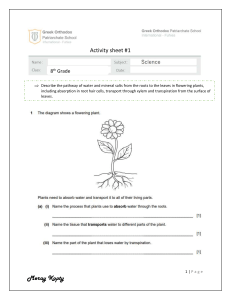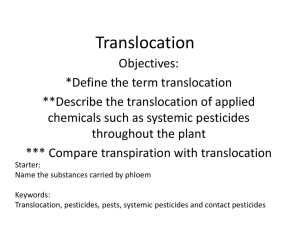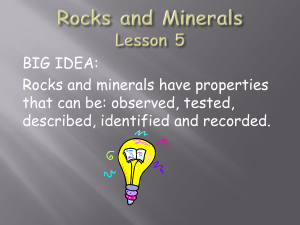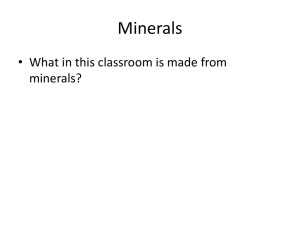Transport of mineral salts - Transport in Flowering Plants
advertisement
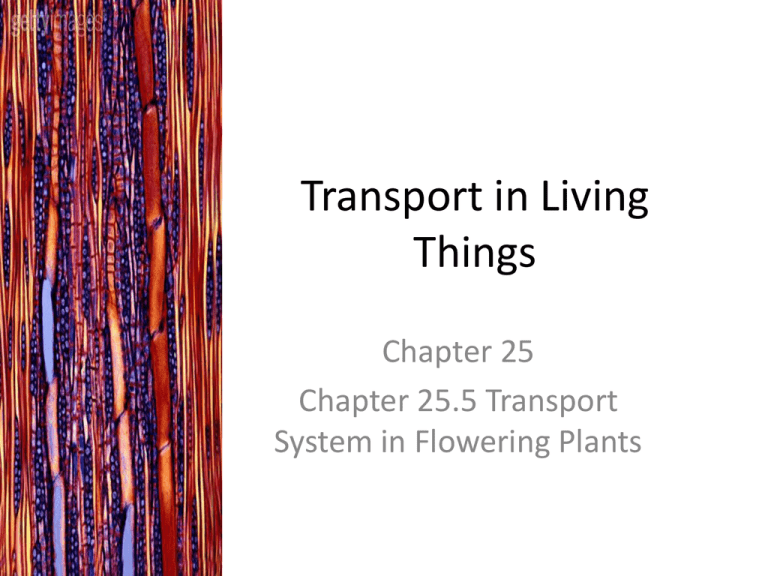
Transport in Living Things Chapter 25 Chapter 25.5 Transport System in Flowering Plants What did we learn? Transport system of plants Consists of Is a living tissue made up of sieve tubes and companion cells Phloem Xylem Water enters Transports food substances roots via osmosis Is a continuous hollow tube with lignified walls Transports water and mineral salts Lesson Objectives At the end of the lesson, You should be able to: • relate the structure and functions of root hairs to their surface area, and to water and ion uptake • state that transpiration is the loss of water vapour from the stomata • define the term translocation as the transport of food in the phloem tissue Transport of mineral salts Plant Profile What process is being used to take in mineral salts? Name: Claudia Owner: Farmer A Characteristics: Is watered and fertilizer is added everyday. Transport of mineral salts Plasma membrane of root hair cell Soil solution Sap in root hair Mineral salts Mineral concentration low Mineral concentration high Diffusion Plant Profile What process is being used to take in mineral salts? Name: Lydia Owner: No one Characteristics: No one takes care of it and the soil is dry and mineral- poor. Transport of mineral salts Qn: Can the root hair absorb ions if the concentration is higher in the root hair sap compared to the soil solution? Yes!!! Plasma membrane of root hair cell Soil solution Sap in root hair Mineral salts? Mineral concentration high Mineral concentration low Active transport Translocation Definition: It is the transport of manufactured food substances such as sugars and amino acids in plants. How can we show that the phloem carries materials from the leaves to other parts of the plant? “Ringing” experiment 1) Take the branch of a woody plant 2) Remove a ring of bark from around the main stem. 3) Put it into water 4) Observe it over a few weeks “Ringing” experiment A B Region with bark removed Water Unringed twig After a few weeks… • The part of the stem just above the cut region will swell Transpiration Definition of transpiration: The loss of water vapour from the aerial parts of the plant, especially through the stomata of the leaves Similarity? Functions of transpiration: 1. Cool the plant; prevent scorching 2. Facilitates the lifting of water and mineral salts from roots to leaves Transpiration pull Evaporation of water from leaves Leaf cells lose water Cells remove water from xylem vessels concentrated cell sap = lower water potential Creates a transpiration pull Draw water from cells deeper inside the leaf by osmosis The evaporation of water from leaves result in a suction force which pulls water up the xylem vessels Suction force due to transpiration is transpiration pull Factors affecting transpiration rate 1. 2. 3. 4. 5. Humidity of air Temperature of air Strong wind Light Size and shape of leaves (surface area) Summary Water Diffuses out of Leaves or aerial parts of the plant enters Mineral salts enters roots Osmosis Travels from roots via via Food substances via Diffusion Transpiration Is the loss of water vapour from the aerial parts of the plant leaf to Other Active parts ofof Is the transport transport manufactured food the plant substances such as viaand amino sugars acids in the plants Translocation
